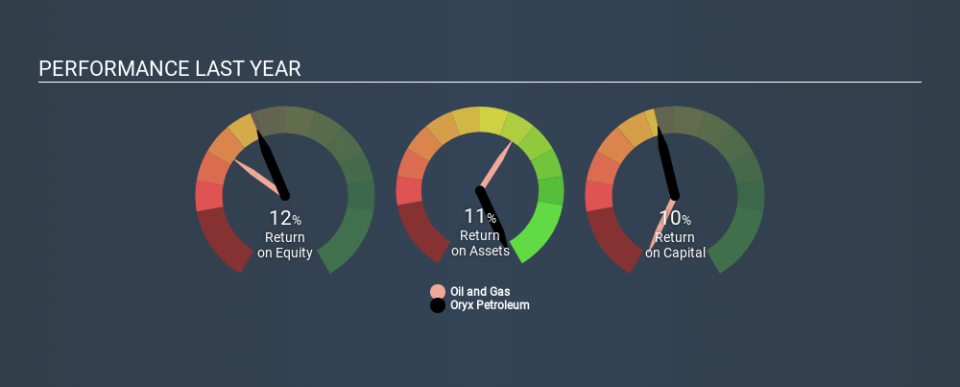Should You Like Oryx Petroleum Corporation Limited’s (TSE:OXC) High Return On Capital Employed?

Today we are going to look at Oryx Petroleum Corporation Limited (TSE:OXC) to see whether it might be an attractive investment prospect. To be precise, we'll consider its Return On Capital Employed (ROCE), as that will inform our view of the quality of the business.
First of all, we'll work out how to calculate ROCE. Then we'll compare its ROCE to similar companies. And finally, we'll look at how its current liabilities are impacting its ROCE.
Return On Capital Employed (ROCE): What is it?
ROCE measures the 'return' (pre-tax profit) a company generates from capital employed in its business. All else being equal, a better business will have a higher ROCE. Ultimately, it is a useful but imperfect metric. Author Edwin Whiting says to be careful when comparing the ROCE of different businesses, since 'No two businesses are exactly alike.
How Do You Calculate Return On Capital Employed?
The formula for calculating the return on capital employed is:
Return on Capital Employed = Earnings Before Interest and Tax (EBIT) ÷ (Total Assets - Current Liabilities)
Or for Oryx Petroleum:
0.10 = US$75m ÷ (US$827m - US$105m) (Based on the trailing twelve months to September 2019.)
Therefore, Oryx Petroleum has an ROCE of 10%.
Check out our latest analysis for Oryx Petroleum
Is Oryx Petroleum's ROCE Good?
One way to assess ROCE is to compare similar companies. In our analysis, Oryx Petroleum's ROCE is meaningfully higher than the 5.4% average in the Oil and Gas industry. I think that's good to see, since it implies the company is better than other companies at making the most of its capital. Regardless of where Oryx Petroleum sits next to its industry, its ROCE in absolute terms appears satisfactory, and this company could be worth a closer look.
Oryx Petroleum reported an ROCE of 10% -- better than 3 years ago, when the company didn't make a profit. That implies the business has been improving. You can see in the image below how Oryx Petroleum's ROCE compares to its industry. Click to see more on past growth.
When considering this metric, keep in mind that it is backwards looking, and not necessarily predictive. ROCE can be misleading for companies in cyclical industries, with returns looking impressive during the boom times, but very weak during the busts. ROCE is, after all, simply a snap shot of a single year. Remember that most companies like Oryx Petroleum are cyclical businesses. How cyclical is Oryx Petroleum? You can see for yourself by looking at this free graph of past earnings, revenue and cash flow.
Do Oryx Petroleum's Current Liabilities Skew Its ROCE?
Liabilities, such as supplier bills and bank overdrafts, are referred to as current liabilities if they need to be paid within 12 months. Due to the way ROCE is calculated, a high level of current liabilities makes a company look as though it has less capital employed, and thus can (sometimes unfairly) boost the ROCE. To check the impact of this, we calculate if a company has high current liabilities relative to its total assets.
Oryx Petroleum has total assets of US$827m and current liabilities of US$105m. Therefore its current liabilities are equivalent to approximately 13% of its total assets. Current liabilities are minimal, limiting the impact on ROCE.
Our Take On Oryx Petroleum's ROCE
This is good to see, and with a sound ROCE, Oryx Petroleum could be worth a closer look. There might be better investments than Oryx Petroleum out there, but you will have to work hard to find them . These promising businesses with rapidly growing earnings might be right up your alley.
I will like Oryx Petroleum better if I see some big insider buys. While we wait, check out this free list of growing companies with considerable, recent, insider buying.
If you spot an error that warrants correction, please contact the editor at editorial-team@simplywallst.com. This article by Simply Wall St is general in nature. It does not constitute a recommendation to buy or sell any stock, and does not take account of your objectives, or your financial situation. Simply Wall St has no position in the stocks mentioned.
We aim to bring you long-term focused research analysis driven by fundamental data. Note that our analysis may not factor in the latest price-sensitive company announcements or qualitative material. Thank you for reading.

 Yahoo Finance
Yahoo Finance 
